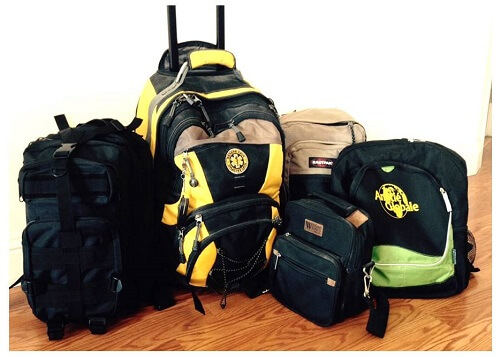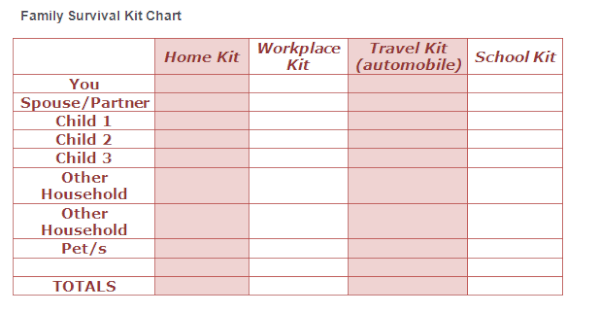One size does NOT fit all
Take a look at your collection of Emergency Kits

Which bag still works?
We regularly (although not often enough) pull out our various emergency kits to see what’s in them, whether they need re-stocking, or maybe even replacing.
Some change is always required!
So over the weekend we took a look at what’s in the various closets and trunks of our cars. The photo shows five of the current collection.
It should raise some questions for you, like it did for us!
1-How many survival kits do we need, anyway?
Joe and I are a two-person household. We’ve written often about the different items that you’d find in our kits:
- The Commuter Bag, stays in the car, designed to get us safely home if something happens when we’re on the road. One 2-person kit per car.
- The 72-hour Survival Kit, the true “Grab and Go Bag” for immediate use in an emergency. We each have one.
- The 14-day Survival Stash – food and other supplies that will carry us through in the case of massive storm, big earthquake, etc. The Stash is spread around the house, and doesn’t leave it.
When it comes to Survival Kits, we have published a whole workbook. Below is one of the charts from it. You’ll see that the chart adds a Workplace Kit and a School Kit to the other two. Now, we work from home, and don’t have kids at school, so they aren’t on our own list. Nor do we have pets. But what about your family? (Get the details of the workbook here. If you haven’t really begun assembling your preparedness items, this may be just the kick-start you’re looking for.)

2-So are the kits different?
I think EACH kit needs to be unique! Not entirely, of course. We’ve written before about the top 10 items to consider for each short-term kit. (Here’s the Top Ten list of Emergency Kit Starter Items, with discussion.) Some of these, for example knives or other tools, might be inappropriate for small children or older people.
But as soon as you stop to think about it, you will want other stuff in YOUR kit that no one else might think of. And there are things others in your family might need that you have no interest in packing for yourself. For example:
- Personal items — toothbrush, floss, tampons, diapers, eye shades, sunscreen, glasses/contacts, dark glasses, chewing gum, etc.
- Medical items – pills, allergy cream, bee sting kit
- Comfort items – candy, toys, a book
Most of these extras don’t take up much room, but without yours you’d be miserable!
3-What’s the best container for a kit?
So again, it depends. How much needs to go into the kit? Who is going to be carrying it and how far? If you look again at the photo, you’ll see some kits which have turned out to be pretty good for us, and others that really don’t make the grade. Here’s some of what to consider.
SIZE – We got the Big Yellow/Black Banana Pak Kit (center of the photo) early on. It was designed and sold by a thorough professional – everything you’d need, of the very best quality including the bag itself. Unfortunately, the minute it arrived we realized it was TOO BIG AND TOO HEAVY. I’ve kept it in the back of the closet because I really like some of the specialty items (whistles, binoculars, knives) but it is now relegated to the long-term, permanently stored Survival Stash. I can hardly carry the darn thing. Fortunately it has wheels.
Other kits in the photo are at the other end of the scale. For example, the small black kit with green base was one that we actually sold on Amazon as part of a “starter kit.” It works fine as a Commuter Bag – room for snacks, water bottle, flashlights, radio, a jacket. But with only two compartments, it’s not very flexible.
My latest acquisition is the black “Tactical Bag” at the left in the photo above, and here in a closer look.
I just received it (That’s why it’s empty!) and it seems to have a number of attractive features:

- All the straps are adjustable, and the body of the bag is expandable. (I adjusted the shoulder straps. Took a while, what with all the buckles and loops.)
- It’s made for carrying long distances – with a front chest strap and a belly strap, padded shoulder straps, etc. Everything cinches down tight for comfort and control.
- The bag has 9 different pockets of varying size. The larger pockets zip all around for easy opening.
- Multiple straps and loops make it possible to easily attach more gear: a jacket, bottles, blanket, lights, boots, weapons, whatever.
- Bag is waterproof. (I always pack a couple of large trash bags so I can cover the whole pack in one fell swoop!)
A quick detour for vocabulary:
I described this bag as a “tactical” bag. This definition of tactical comes from The Free Dictionary:
Tactical — characterized by skillful tactics or adroit maneuvering or procedures especially in military or naval operations.
Molle — And in reviewing backpacks I also discovered the word “Molle” which stands for Modular Lightweight Load-carrying Equipment. It refers to the ability of a backpack like this one to attach other modular gear components: vests, pouches, etc.
QUALITY – As I already mentioned, the big yellow pack is made of the highest quality materials. It rolls like luggage, has shoulder straps, and can be carried by a top handle or a side handle like a duffle bag. Its zippers are industrial strength, as is the canvas bag itself. Real leather zipper pulls. Special separate pockets for different items: glasses, water, etc. Top quality, top price, heaviest by far!
The green/black “starter kit” is medium grade nylon material, with ordinary zipper and fabric zipper pulls. Medium quality, inexpensive, very lightweight.
The other bags in the photo lie somewhere in between.
If you are going to store a kit in the car and only grab it in an emergency, a medium quality bag will work fine. (Keep it out of the sunlight, of course!)
On the other hand, if you plan to carry your bag on arduous hikes or use it camping, or even as a daily carry full of books, invest in the best quality you can afford. Nothing worse than a broken zipper when you need reliability!
So go back to your chart. You are likely to need multiple kits – for different needs, for different people. (You may want to start with some used backpacks you already own, just to get a better idea of how much each pack needs to hold and thus how big it needs to be.)
Start building your kits. Soon, you will have a collection just like ours!
4-Consider a “Tactical Bag” for your collection.
There are plenty of backpacks out there labeled “tactical.” Some are absolutely huge! For your first survival kit purchase, you might consider something smaller, like this one, available from Amazon at what appears to be an excellent price. And this one gets some of the best Amazon reviews I’ve seen. (I always read all of them.)
Click on the link for details and the current price. (Remember, we’re Amazon associates and may get a small commission for sending you there to buy.)
Over the years we’ve worn out a number of bags and backpacks, so we’re always on the lookout for new ones for our stuff. And our “stuff” has changed, too, as we’ve moved around the country.
No matter where or when, however, we try to have a survival kit handy. When the emergency hits, it’s too late to start searching for what you need!
Virginia
Your Emergency Plan Guide Team




 If you think you are already prepared, use this list as a quick check. If you suspect you’re missing a few things, use the list to fill in the gaps.
If you think you are already prepared, use this list as a quick check. If you suspect you’re missing a few things, use the list to fill in the gaps.
 “We cannot store enough food and water to be of help to you in an emergency, but here is a bottle of water to show our good faith. We hope you will recognize the need to be prepared and – using the list on the back of this letter – make sure your entire household is protected.”
“We cannot store enough food and water to be of help to you in an emergency, but here is a bottle of water to show our good faith. We hope you will recognize the need to be prepared and – using the list on the back of this letter – make sure your entire household is protected.” The Home Depot – the place to start
The Home Depot – the place to start